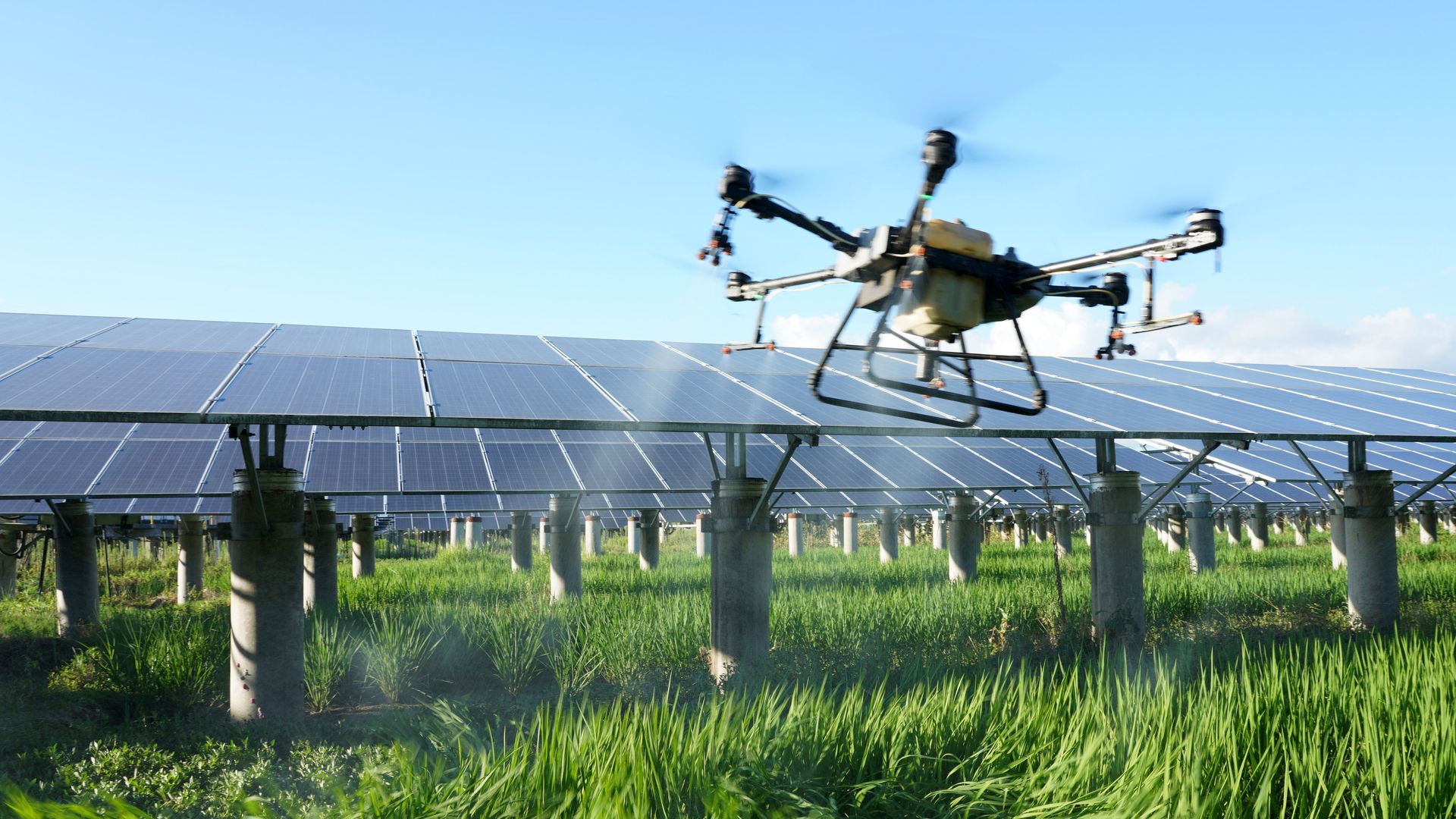| |
| |
| |
| Presented By Aventiv Technologies |
| |
| Axios What's Next |
| By Joann Muller, Alex Fitzpatrick and Jennifer A. Kingson · Aug 08, 2022 |
| For her story today, Joann dove into a critically important question: Who's going to pay for all these EV chargers we're building? The answer, it turns out, may be all of us. Today's Smart Brevity count: 1,030 words ... 4 minutes. |
| |
| |
| 1 big thing: Who will pay for EV charging? Everyone |
 |
|
| Illustration: Aïda Amer/Axios |
| |
| Americans nationwide will likely face higher electric bills to pay for the next stage of the country's electric vehicle (EV) charger buildout, Joann Muller reports. Why it matters: The U.S. will need a massive investment in public charging infrastructure to match the anticipated spike in EV demand. But such capital outlays don't make economic sense for many companies until there are more EVs on the road — which won't happen until there are more chargers. - It's a classic chicken-and-egg scenario that, in the near term, is likely to be solved by regulated public utilities that can pass on the burden to their customers.
What's happening: Power utilities across the country are planning to build extensive EV charging networks. - Minnesota-based Xcel Energy, for instance, last week announced perhaps the boldest such proposal: It plans to spend $170 million for about 750 fast-charging stations in Minnesota and Wisconsin over the next four years.
- The states' public utility commissions need to approve the plan, which would ultimately be covered by Xcel ratepayers.
- Xcel says the plan would encourage its customers to buy EVs by offering them a steep discount at its charging stations.
- But for everyone else — including those who can't afford an EV — it just means steeper electricity bills, given that many communities only have a single utility.
The big picture: Virtually every state is confronting thorny economic and policy issues associated with the EV transition. - Who will build and maintain the required charging stations? Who will profit from them? And importantly, who will pay for them?
The intrigue: There's a battle emerging between utilities and gas stations, convenience stores and other private businesses also trying to get into the vehicle-charging game. - Stores and gas stations offering EV charging may wind up competing with the very same utilities they're paying for the power flowing into customers' cars.
Yes, but: Retailers say the way they're billed for power leaves them at a disadvantage. - Utilities apply so-called "demand charges" based on the maximum amount of power commercial ratepayers use at any point during their billing cycle.
- So if just one customer plugs their EV into a 150-kWh fast-charger for 30 minutes, causing power demand to spike, a store would be billed at the peak demand level for the entire month.
- "I'm terrified of getting hit with an EV demand charge," says Raina Shoemaker, who operates a family-run truck stop in Lincoln, Nebraska.
What to watch: Retailers want regulators to establish a fixed wholesale price for electricity to level the playing field. What's next: Private businesses will eventually own and operate most of the EV charging network, because they know how to compete on price, service and amenities, says Mark Boyadjis, global technology lead at S&P Global Mobility. - But for now, utilities could have a head start, and electricity customers will pay.
Share this story. |
    |
| |
| |
| 2. A boost for carbon capture |
 |
|
| A carbon capture facility in Iceland. Photo: Arnaldur Halldorsson/Bloomberg via Getty Images |
| |
| Congress' climate deal could help scale-up carbon capture technology after years of limited momentum, Axios' Ben German writes. Driving the news: The package provides a long-term extension for projects to qualify for existing credits and expands their application and value. - And it boosts subsidies for nascent "direct air capture" tech — though that's not slated to start sucking big CO2 volumes from the atmosphere any time soon.
Why it matters: Trapping CO2 can complement climate-friendly energy sources like renewables, storage and clean hydrogen. - Yet high costs and other barriers have long thwarted major deployment.
Yes, but: Nothing's guaranteed with carbon capture, which will require a build-out of transport, approval of storage sites and more. |
    |
| |
| |
| 3. What's behind Amazon's Roomba deal? |
 |
|
| Photo courtesy of iRobot |
| |
| Amazon's $1.7 billion deal to acquire iRobot maker Roomba probably isn't about robotic vacuums, Bloomberg's Alex Webb argues — it's about data. - Roombas are good at what they do largely because they meticulously map users' homes to better clean them.
- Those maps could be helpful in Amazon's smart home ambitions. The more a smart home knows about a given space, "the more tightly it can choreograph the way [smart devices] interact with you," Webb writes.
Knowing more about your home could also bolster Amazon's marketing efforts. - "A floor covered in toys means you likely have kids," Webb writes. "A household without much furniture is a household to which you can try to sell more furniture."
Yes, but: There's no guarantee federal regulators — who just unexpectedly sued Facebook parent Meta to block a virtual reality acquisition — will approve the deal. - It's also unclear how Amazon might actually use any data hoovered up by Roombas.
Alex's thought bubble: If Amazon winds up buying iRobot, I'd probably be a little less likely to get a Roomba. But I also have a handful of Alexa gadgets, so I'm not super hardline on in-home digital privacy. |
    |
| |
| |
| A message from Aventiv Technologies |
| Technology can empower rehabilitative justice and reduce recidivism |
| |
 |
| |
| Aventiv Technologies is ending technology deserts in correctional facilities and helping those incarcerated stay connected and build new lives. Here's how: Aventiv is on pace to distribute 600,000 free tablets with educational content. It reduced call rates by more than 25%. Find out more. |
| |
| |
| 4. 📸: Solar farms ... literally |
 |
|
| A drone sprays pesticide on seawater rice growing under solar panels at an agrivoltaic farm in Wenzhou, Zhejiang Province, China. Photo: Cai Kuanyuan/VCG via Getty Images |
| |
| The hot new thing in agriculture? Agrivoltaics, wherein the same land is used for both growing crops and collecting solar energy — as seen in the above photo. How it works: "A symbiotic 'cooling' relationship occurs when growing crops ... under solar panels," reads a U.S. Department of Agriculture info sheet. - "Shade reduces air temperature and the amount of water evaporating from soils. The plants in turn give off water vapor that helps to naturally cool the [solar] panels from below, which can increase panel efficiency."
Yes, but: It's still early days for this intriguing approach, and it's not yet clear whether it's scalable. |
    |
| |
| |
| 5. One fun thing: Happy birthday, Curiosity! |
 |
|
| Illustration: Maura Losch/Axios |
| |
| NASA's Curiosity rover celebrates its 10th anniversary on Mars this month, Axios' Miriam Kramer reports. Why it matters: Curiosity's discoveries transformed how scientists understand the red planet. The backstory: Curiosity's mission was meant to last just two years when it landed on Mars in August 2012. But 10 years later, the rover continues on. So far, Curiosity has ... - Found what used to be an ancient stream bed once home to an ankle-to-hip-deep river.
- Discovered that Mars hosts organic molecules — the building blocks of life.
- Shown that methane is being released into the Martian atmosphere, a possible sign of life (or the result of normal geology).
What's next: Curiosity's nuclear batteries will eventually run dry, but NASA officials expect it to be roving the red planet for at least five more years. |
    |
| |
| |
| A message from Aventiv Technologies |
| Creating connections for those who need it most |
| |
 |
| |
| Many correctional facilities are digital deserts. Incarcerated individuals need more ways to connect with family and build new lives. The solution: Aventiv is delivering 600,000 free tablets with educational content and cut call rates by over 25%. See all the progress. |
| |
| A hearty thanks to What's Next copy editor Kathie Bozanich. Was this email forwarded to you? Get your daily dose of What's Next magic by signing up here for our free newsletter. |
 | | Are you a fan of this email format? It's called Smart Brevity®. Over 300 orgs use it — in a tool called Axios HQ — to drive productivity with clearer workplace communications. | | |









No comments:
Post a Comment